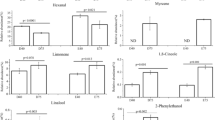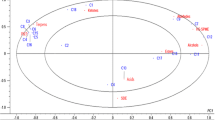Abstract
During the last few years, there has been a tremendous increase in consumption of pomegranate fruit and juice. Nevertheless, very little is yet known regarding the volatile constituents that determine the unique aroma of pomegranate fruit. We extracted aroma volatiles from fresh ‘Wonderful’ pomegranate juice using solvent-assisted flavour evaporation (SAFE) and headspace solid-phase micro-extraction (HS-SPME) methods, and applied gas chromatography–olfactometry (GC–O) (‘sniffing’) combined with gas chromatography–mass spectrometry (GC–MS) analysis, in order to identify volatile aroma-active compounds. In addition, we performed stir bar sorptive extraction (SBSE) of pomegranate aroma volatiles, coupled with GC–MS analysis, in order to assist in identifying aroma-active compounds. Overall, we tentatively identified 23 volatiles in the SAFE and HS-SPME extracts; they belonged to various chemical classes, including aldehydes, terpenes, alcohols, esters, furans and acids. Using the GC–O nasal impact frequency method, we tentatively detected 12 aroma-active peaks and identified the corresponding odourants by GC–MS. The aroma-active compounds of ‘Wonderful’ pomegranates were ethyl-2-methylbutanoate (fruity, apple), hexanal (green), β-pinene (pine, herbal), β-myrecene (woody, musty), cis-3-hexenal (green), limonene (fruity, musty), cis-2-heptenal (soapy, mushroom), cis-3-hexenol (earthy, grassy), 2-ethylhexanol (floral), β-caryophyllene (fruity, musty), 2(5H)-furanone (sweet, fruity) and β-sesquiphellandrene (terpene, almond). Overall, the flavour of ‘Wonderful’ pomegranate fruit derives from a mixture of various ‘green’, ‘woody’, ‘earthy’, ‘fruity’, ‘floral’, ‘sweet’ and ‘musty’ notes.


Similar content being viewed by others
References
Holland D, Hatib K, Bar-Ya’akov I (2009) Pomegranate: botany, horticulture, breeding. Hort Rev 35:127–191
Facial A, Ocalhau CA (2011) The bioactivity of pomegranate: impact on health and disease. Crit Rev Food Sci Nutr 51:626–634
Johanningsmeier SD, Harris GK (2011) Pomegranate as a functional food and nutraceutical source. Annu Rev Food Sci Technol 2:181–201
Viuda-Martos M, Fernández-López J, Pérez-Álvarez JA (2010) Pomegranate and its many functional components as related to human health: a review. Compr Rev Food Sci Food Saf 9:635–654
Rymon D (2011) Mapping features of the global pomegranate market. Acta Hort 890:599–602
Calín-Sánchez A, Martínez JJ, Vázquez-Araú L, Burló F, Melgarejo P, Carbonell-Barrachina AA (2011) Volatile composition and sensory quality of Spanish pomegranates (Punica granatum L.). J Sci Food Agric 91:586–992
Melgarejo P, Sánchez AC, Vázquez-Araújo L, Hernández F, José Martínez J, Legua P, Carbonell-Barrachina AA (2011) Volatile composition of pomegranates from 9 Spanish cultivars using headspace solid phase microextraction. J Food Sci 76:S114–S120
Vazquez-Araujo L, Koppel K, Chambers E IV, Adhikaria K, Carbonell-Barrachina AA (2011) Instrumental and sensory aroma profile of pomegranate juices from the USA: differences between fresh and commercial juice. Flavour Fragr J 26:129–138
Vazquez-Araujo L, Chambers E, Adhikaria K, Carbonell-Barrachina AA (2011) Physico-chemical and sensory properties of pomegranate juices with pomegranate albedo and carpellary membranes homogenate. LWT Food Sci Technol 44:2119–2125
Cadwallader KR, Tamamoto LC, Sajuti SC (2010) Aroma components of fresh and stored pomegranate (Punica granatum L.) juice. In: Da Costa NC, Cannon RJ (eds) ACS Symposium Series 1036. American Chemical Society, Washington, pp 93–101
Engel E, Bahr W, Schieberle P (1999) Solvent assisted flavour evaporation—a new and versatile technique for the careful and direct isolation of aroma compounds from complex food matrices. Eur Food Res Technol 209:237–241
Steffen A, Pawliszyn J (1996) Analysis of flavor volatiles using headspace solid-phase microextraction. J Agric Food Chem 44:2187–2193
Baltussen E, Sandra P, David F, Cramers C (1999) Stir bar sorptive extraction (SBSE), a novel extraction technique for aqueous samples: theory and principles. J Microcolumn Sep 11:737–747
Pollien P, Ott A, Montigon F, Baumgartner M, Munoz-Box R, Chaintreau A (1997) Hyphenated headspace-gas chromatography-sniffing technique: screening of impact odorants and quantitative aromagram comparisons. J Agric Food Chem 45:2630–2637
Bansleben AC, Schellenberg I, Einax JW, Schafer K, Ulrich D, Bansleben D (2009) Chemometric tools for identification of volatile aroma-active compounds in oregano. Anal Bioanal Chem 395:1503–1512
Komes D, Ulrich D, Lovric T (2006) Characterization of the odor active compounds in Croatian Rhine Riesling wine, subregion Zagorje. Euro Food Res Tech 222:1–7
Tietel Z, Porat R, Weiss K, Ulrich D (2011) Identification of aroma-active compounds in fresh and stored ‘Mor’ mandarins. Int J Food Sci Technol 46:2225–2231
Ulrich D, Hoberg E, Neugebauer W, Tiemann H, Darsow U (2000) Investigation of the boiled potato flavor by human sensory and instrumental methods. Am J Potato Res 77:111–117
Wijaya H, Ulrich D, Lestari R, Schippel K, Ebert G (2005) Identification of potent odorants in different cultivars of snake fruit [Salacca zalacca (Geart.) voss] using gas chromatography-olfactometry. J Agric Food Chem 53:1637–1641
Goodner KL (2008) Practical retention index models of OV-101, DB-1, DB-5, and DB-Wax for flavor and fragrance compounds. LWT 41:951–958
Belitz H-D, Grosch W, Schieberle P (2009) Food Chemistry. Springer, Berlin
Acknowledgments
This manuscript is contribution no. 629/12 from the Agricultural Research Organization, the Volcani Center, POB 6, Bet Dagan 50250, Israel.
Author information
Authors and Affiliations
Corresponding author
Rights and permissions
About this article
Cite this article
Mayuoni-kirshinbaum, L., Tietel, Z., Porat, R. et al. Identification of aroma-active compounds in ‘wonderful’ pomegranate fruit using solvent-assisted flavour evaporation and headspace solid-phase micro-extraction methods. Eur Food Res Technol 235, 277–283 (2012). https://doi.org/10.1007/s00217-012-1757-0
Received:
Revised:
Accepted:
Published:
Issue Date:
DOI: https://doi.org/10.1007/s00217-012-1757-0




